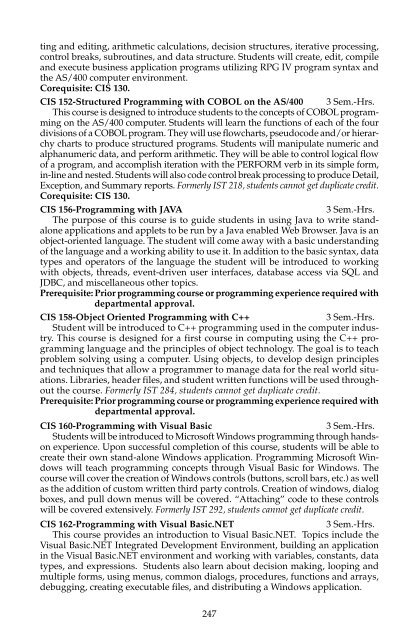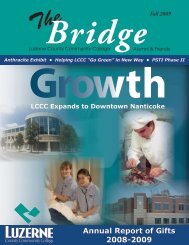2004-2005 COLLEGE CATALOG - Luzerne County Community ...
2004-2005 COLLEGE CATALOG - Luzerne County Community ...
2004-2005 COLLEGE CATALOG - Luzerne County Community ...
You also want an ePaper? Increase the reach of your titles
YUMPU automatically turns print PDFs into web optimized ePapers that Google loves.
ting and editing, arithmetic calculations, decision structures, iterative processing,<br />
control breaks, subroutines, and data structure. Students will create, edit, compile<br />
and execute business application programs utilizing RPG IV program syntax and<br />
the AS/400 computer environment.<br />
Corequisite: CIS 130.<br />
CIS 152-Structured Programming with COBOL on the AS/400 3 Sem.-Hrs.<br />
This course is designed to introduce students to the concepts of COBOL programming<br />
on the AS/400 computer. Students will learn the functions of each of the four<br />
divisions of a COBOL program. They will use flowcharts, pseudocode and/or hierarchy<br />
charts to produce structured programs. Students will manipulate numeric and<br />
alphanumeric data, and perform arithmetic. They will be able to control logical flow<br />
of a program, and accomplish iteration with the PERFORM verb in its simple form,<br />
in-line and nested. Students will also code control break processing to produce Detail,<br />
Exception, and Summary reports. Formerly IST 218, students cannot get duplicate credit.<br />
Corequisite: CIS 130.<br />
CIS 156-Programming with JAVA 3 Sem.-Hrs.<br />
The purpose of this course is to guide students in using Java to write standalone<br />
applications and applets to be run by a Java enabled Web Browser. Java is an<br />
object-oriented language. The student will come away with a basic understanding<br />
of the language and a working ability to use it. In addition to the basic syntax, data<br />
types and operators of the language the student will be introduced to working<br />
with objects, threads, event-driven user interfaces, database access via SQL and<br />
JDBC, and miscellaneous other topics.<br />
Prerequisite: Prior programming course or programming experience required with<br />
departmental approval.<br />
CIS 158-Object Oriented Programming with C++ 3 Sem.-Hrs.<br />
Student will be introduced to C++ programming used in the computer industry.<br />
This course is designed for a first course in computing using the C++ programming<br />
language and the principles of object technology. The goal is to teach<br />
problem solving using a computer. Using objects, to develop design principles<br />
and techniques that allow a programmer to manage data for the real world situations.<br />
Libraries, header files, and student written functions will be used throughout<br />
the course. Formerly IST 284, students cannot get duplicate credit.<br />
Prerequisite: Prior programming course or programming experience required with<br />
departmental approval.<br />
CIS 160-Programming with Visual Basic 3 Sem.-Hrs.<br />
Students will be introduced to Microsoft Windows programming through handson<br />
experience. Upon successful completion of this course, students will be able to<br />
create their own stand-alone Windows application. Programming Microsoft Windows<br />
will teach programming concepts through Visual Basic for Windows. The<br />
course will cover the creation of Windows controls (buttons, scroll bars, etc.) as well<br />
as the addition of custom written third party controls. Creation of windows, dialog<br />
boxes, and pull down menus will be covered. “Attaching” code to these controls<br />
will be covered extensively. Formerly IST 292, students cannot get duplicate credit.<br />
CIS 162-Programming with Visual Basic.NET 3 Sem.-Hrs.<br />
This course provides an introduction to Visual Basic.NET. Topics include the<br />
Visual Basic.NET Integrated Development Environment, building an application<br />
in the Visual Basic.NET environment and working with variables, constants, data<br />
types, and expressions. Students also learn about decision making, looping and<br />
multiple forms, using menus, common dialogs, procedures, functions and arrays,<br />
debugging, creating executable files, and distributing a Windows application.<br />
247



